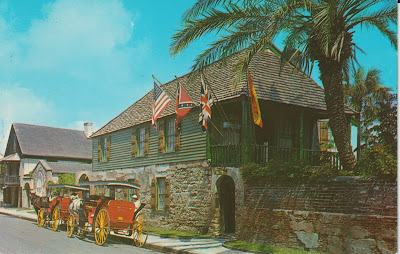The Oldest House, St. Augustine, Florida
St. Augustine is located on the northeastern coast of Florida. The Oldest House, also called the González-Alvarez House, is shown on this unused postcard. The card, distributed by Florida Souvenir Co., of St. Augustine, has the number 49987 at the center bottom of the reverse side. The photographer is not identified. There is an information blurb at the upper left corner on the reverse: “The Oldest House, St. Augustine, Florida constructed in the late 1500’s, this ancient Spanish house is an outstanding example of Old World historical preservation. Open to the public as an historical museum.” It is hard to tell how old the photograph might be; however, more recent pictures indicate that the “stars and bars” flag of the confederacy is no longer displayed on the building.
The two-story house is located in a residential area south of the downtown. The first floor is built of coquina limestone, a sedimentary rock composed of fragments of mullusk, trilobite, brachiopod, and other invertebrate shells. The word “coquina” comes from the Spanish word for shellfish or cockle. The upper floor is wood framed with a clapboard exterior. The hip roof is finished with wooden shingles. Multiple alterations and enlargements have been done at different times since the original construction. There is a discrepancy in the dating of the construction with the postcard blurb dating the house in the 1500’s; other sources show 1625, and the oldest documented portions of the current structure dates from around 1723. It was built in the Spanish colonial architectural style with later modifications by English owners.
The first people to live in the house were members of the family and descendants of Tomas González y Hernandez and Maria Francisco de Guevara (1625-1763). In 1763 the British took over Florida and the Gonzáles family left for Cuba. An Englishman, Major Joseph Peavett, purchased the house in 1774 and added the wood-frame second floor, put in glass windows where the openings had only had wooden shutters previously. The third owner, Geronimo Alvarez, added a two-story wing built of coquina. During the years from 1882 to 1918 the house changed hands several times and was even the home of the South Beach Alligator Farm from 1911 to 1918. In 1918 the St. Augustine Historical Society took over the property and undertook a restoration in 1959-1960 that reversed a number of earlier alterations and left the building appearing as a late 19th century structure.
Thick walls help to provide insulation from hot weather, an open, covered loggia, or open corridor, allowed the wind to circulate aiding cooling in the building. The interior floors are made of tabby concrete, a mixture of lime made from oyster shells, broken oyster shells, sand, ash and water.
For additional information, see:
https://en.wikipedia.org/wiki/González-Alvarez_House
https://en.wikipedia.org/wiki/Coquina
https://en.wikipedia.org/wiki/St._Augustine_Florida
https://en.wikipedia.org/wiki/Loggia
https://en.wikipedia.org/wiki/Tabby_concrete

No comments:
Post a Comment